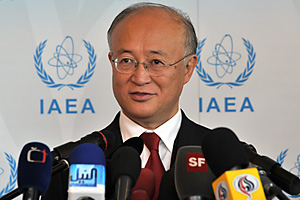A new report issued by the IAEA today rehashed complaints about what was referred to as a minor, technical violation last week, and declared that it “raises concerns about the possible existence in Iran of past or current undisclosed activities related to the development of a nuclear payload for a missile.”

Early last week Iran began enrichment of uranium to 20 percent in an attempt to find a new source of fuel for its Tehran Research Reactor, a US-built reactor which produces isotopes for medical purposes.
Officials at the IAEA last week expressed “annoyance” that Iran had moved forward with the program so quickly, insisting that Iran was obliged to delay the start until changes were made to the safeguards agreement. Iran moved forward with the plan anyhow, in what analysts referred to as a “technical” violation.
The IAEA’s new report, issued by new chief Yukiya Amano, uses only this “technical violation” as justification for its speculation about the intention of Iran’s nuclear program, and the claims about a “nuclear payload for a missile” don’t appear to be backed up by any evidence, seemingly only included for shock value.

Though last week’s report on the technical violation stressed that IAEA officials were “irked” by the move, it seems incredible that Secretary General Amano would use what seems to have been a trivial annoyance to fan the fuels of speculation about a covert nuclear program particularly when he himself confirmed previously that the IAEA has absolutely no evidence Iran was seeking nuclear weapons. It is doubly troubling that such a statement would be issued when Western officials are raising the specter of a military attack against Iran.
Despite the sensational language used in the IAEA statement, Iran continues to enrich uranium mostly at 3.5 percent, with a smaller program at 20 percent. A nuclear payload would require enrichment of above 90 percent. The IAEA has continued to verify that Iran is not diverting any of this uranium to any undisclosed purpose. Today’s announcement, alarmist though it may be, appears to be nothing more than a spite move by the IAEA after Iran thumbed their nose at official procedure, and does not represent any real threat.


